The solopreneur’s content repurposing playbook: one video into 10+ posts
You’ve poured hours into writing a blog post, recording a podcast, or hosting an event… only for it to vanish into the void after you hit publish. Sound familiar?
The pressure to always create something new to engage your community is draining. You give it your all, and bring your best ideas to the table, yet it still feels like you’re falling behind. Consistency slips, and showing up online starts to feel impossible.
But what if one piece of content could work ten times harder for you? That’s the power of content repurposing. Instead of scrambling for new ideas, build a system that multiplies your impact and transforms a single event, blog, or video into multiple engaging assets.
Candice Grobler is a Circle Partner and founder of Candid Collab. Through her content, membership, and agency services, she helps solopreneurs build thriving and sustainable online communities.
Jomiro Eming is a designer and storyteller who creates across branding and events, and shares insights through The Freelance Lab and his AI course for freelancers.
In this playbook, we’ll explore Candice’s repurposing system, shared inside the Circle customer community, and Jomiro’s method, which he discussed with Candice on her podcast.
You’ll learn how to design your content with repurposing in mind, streamline your editing workflow, and schedule it out like a pro.
Goal of this playbook
This playbook will walk you through a practical content repurposing strategy that helps your content work harder with less effort from you.
By the end, you’ll know how to:
- Save time by turning one idea into a full content pipeline
- Stay consistent with your publishing schedule, even as a team of one
- Reduce burnout with a repeatable monthly workflow
- Maximize reach by sharing content in different formats for different audiences
- Drive community engagement with fresh, repurposed assets
Jomiro learned this all the hard way. He used to spend hours writing a newsletter. He’d publish it, share the link on LinkedIn, and then immediately scramble to create something new.
“I was just putting it out as a link and hoping people would read,” he shared on Candice’s Candid Collab podcast. “Then I was like, ‘Oh, I need to write another blog post now, ‘cause nothing happened.’”
Once he started to repurpose content, everything shifted. From that same blog, he pulled quotes, designed infographics, and created short posts. One piece of content suddenly became ten, and his social media audience started to respond in new ways.
Step 1: Design your content for repurposing
The easiest way to repurpose content is to plan for it from the start.
That’s what Candice did with her Scrappy Systems event series. Live attendance was low, so she restructured the format to generate more content on the back end.
“I needed to design an interview-format event with various segments that would allow me to easily cut them out and share them as stand-alone pieces. Kind of like The Daily Show or Stephen Colbert,” she explained.
Here’s what she built into every interview:
- The Scrappy Breakdown: Guest explains their most successful marketing system.
- Steal This System: A quick-fire tactic anyone can try.
- My Scrappy Stack: Three must-have tools in their marketing toolkit.
- Flop or Fix: Interactive advice on real use cases from the audience.
- Top Tips: One key takeaway to close out the session.
Now, instead of sifting through an entire recording for good clips, she already has ready-made segments to cut, share, and reuse.
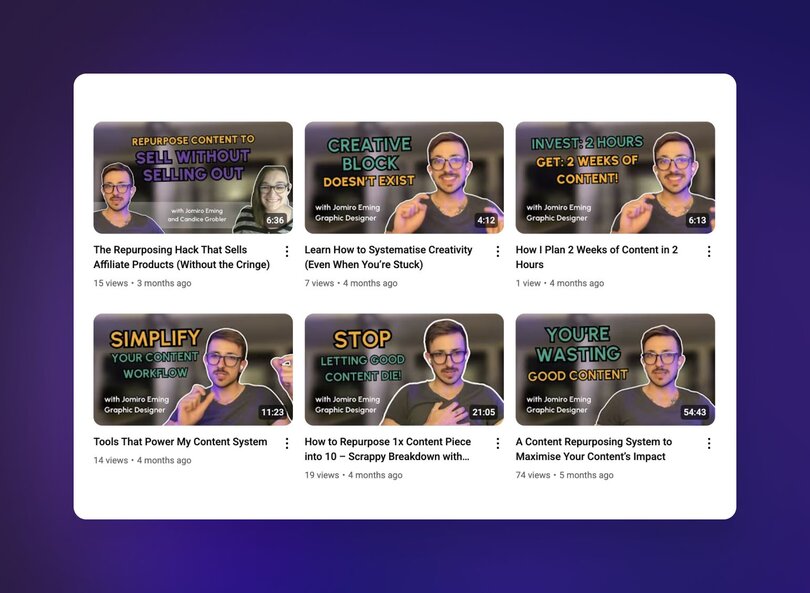
💡 Plan for “repurposable moments” during recorded events. Use this template to design your own:
- Segment Name: [What you’ll call it]
- Example Question: [Prompt or question]
- Format: [Short answer, story, demo, etc.]
- Length: [Approx. minutes]
Step 2: Plan your editing workflow
Hosting the event is only half the job. The other half is turning raw footage into assets without losing steam. A content repurposing strategy lets you move straight from recording to publishing with zero guesswork.
One way to do this is by creating a content yield map. This is a simple, visual outline (like a flowchart) that shows how one larger piece of content can be repurposed into multiple assets. It helps you move away from “let’s just chop up the recording and see what happens” into a clear, intentional plan. A yield map makes it easy to see what you’ll cut, where you’ll use it, and why it matters.
💡 Draft your “content yield” list before pressing record. One event can become a podcast, playlist videos, shorts, posts, and more.
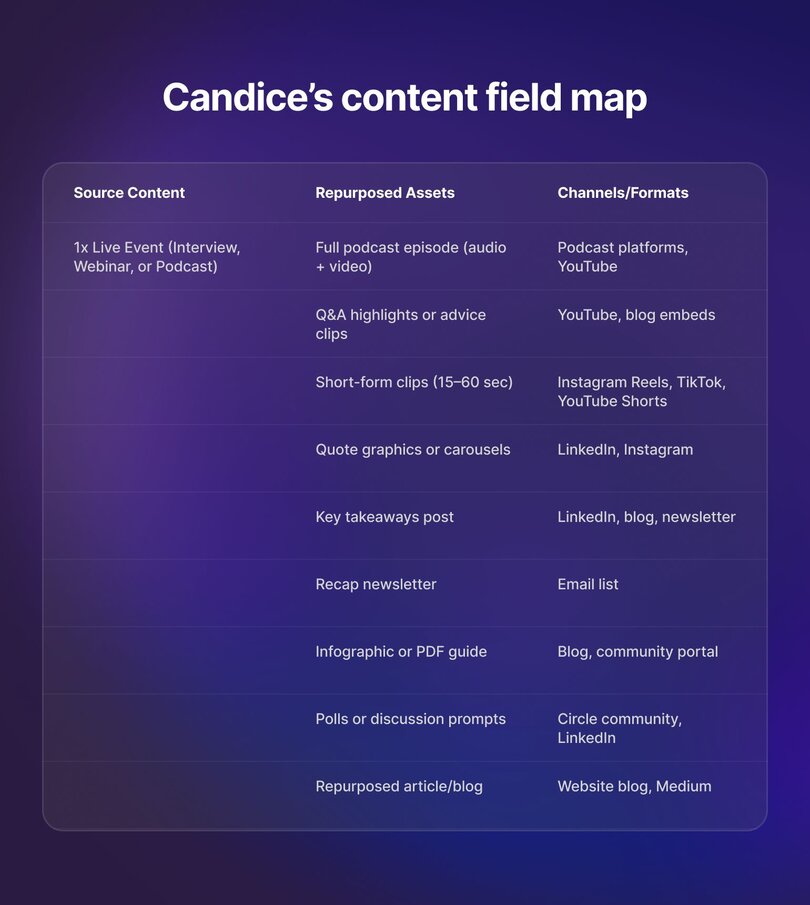
For example, here’s how Candice turns one live event into 11-17 content pieces:
- Run and record the live event (Candice runs interviews with small business marketing experts)
- Edit and polish the event recording.
- Publish the recording as a podcast on YouTube and Spotify → 2 podcast episodes
- Cut 3–5 key moments into shorter playlist videos. → 3–5 videos
- Clip highlights into short-form video for Instagram Reels and YouTube Shorts. → 2-3 videos
- Turn insights into social posts (quotes, graphics, or carousels) for LinkedIn, Instagram, and more. → 3-5 posts
- Share highlights in a bi-weekly newsletter and blog post. → 1–2 written pieces
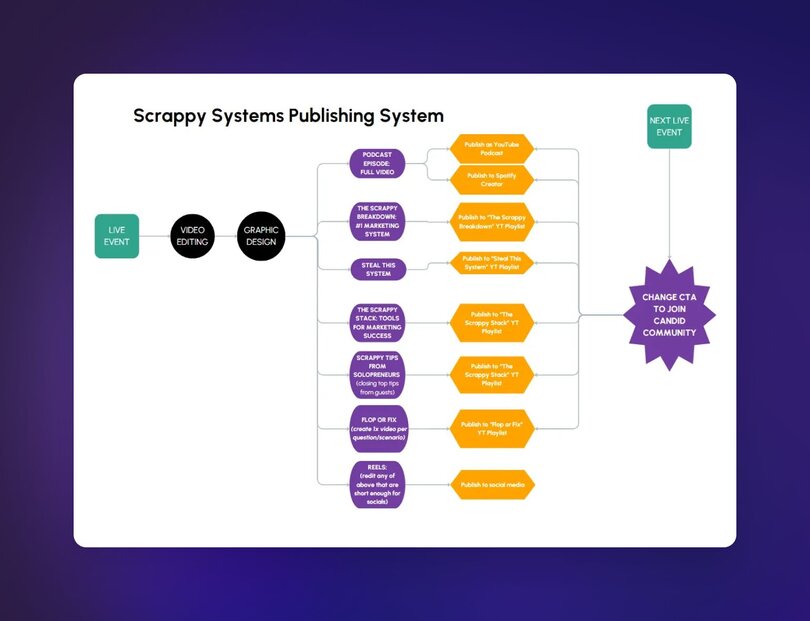
Step 3: Do the hard work once (editing + design)
The biggest trap with repurposing is dragging the work out over weeks. You edit one clip here, design a thumbnail there, and suddenly, content feels never-ending. The smarter move is to design and package everything you need in one go.
That’s how Candice works. “Currently, it takes me one day to create all the content required from the event for the rest of the month,” she says.
Here’s how her stack works together:
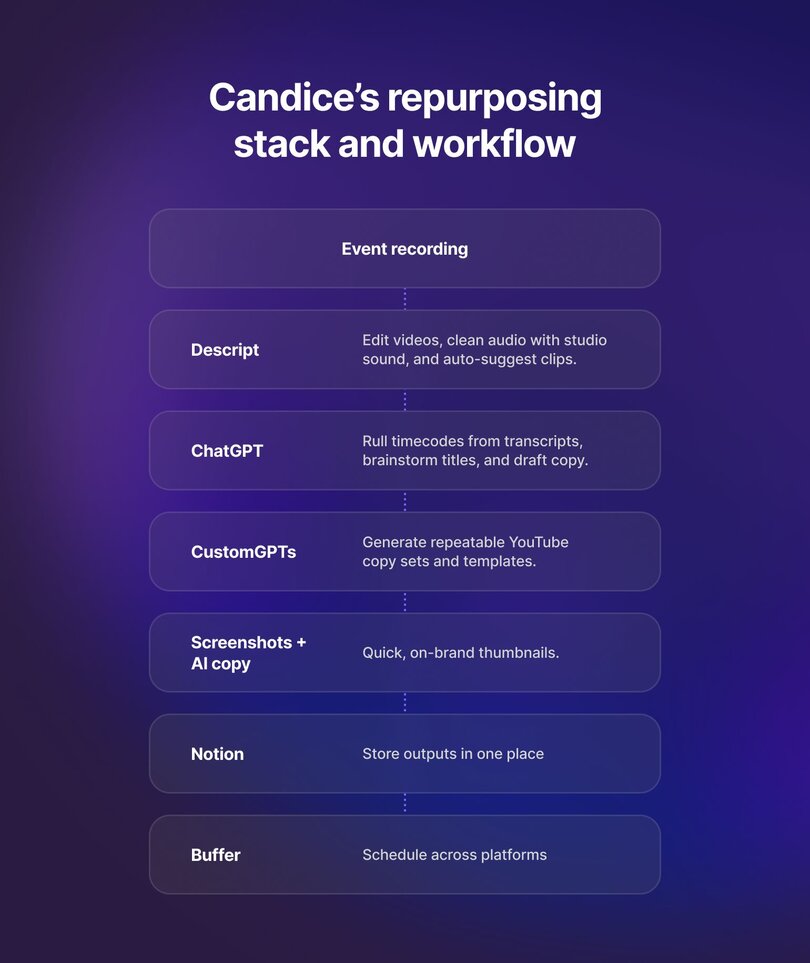
One focused work session gives you weeks of content, so you can spend the rest of your time engaging with your audience.
💡 Invest in one content day per month to batch edit, design, and package all of your repurposed assets.
Step 4: Schedule like a pro
You’ve already batched your editing and design work. Don’t slow yourself down by posting on the fly. Batching your scheduling keeps your head clear and your content consistent.
Jomiro shared that after turning one idea into several pieces, the real stress came from remembering where and when to post them all. Using Buffer, a social media scheduling tool, helps him plan everything in one session, build a clear narrative, and avoid constant context switching.
Candice has a similar approach. She schedules her podcast to launch with a big splash across socials and email, then staggers her segment videos on Tuesdays and Thursdays.
💡 Schedule in blocks. Use a social media scheduling tool to line up weeks of content in one sitting. Then test (What worked well? What didn’t?), iterate, and repeat.
Step 5: Build a repeatable system
When every piece of content fuels the next, you stop scrambling for ideas and start building lasting momentum.
Candice puts it into practice by always planning her next event before publishing the current one. “This allows us to share RSVP details with the event content itself and encourage attendees to join again next time,” she explains.
This approach keeps your community active and your content pipeline full without the constant grind.
💡 Use this checklist to turn one event into a flywheel for future engagement. Before publishing:
✔️ Set the date for your next event.
✔️ Create a landing page or RSVP link.
✔️ Share the sign-up link alongside your new content.
✔️ Track which pieces drive the most community growth.
✔️ Repeat the cycle.
Applying the repurposing playbook as a community manager
Running a community means creating content nonstop. Events, discussions, and member stories pile up quickly, and it’s easy to feel like you’re always producing but never keeping up. A content repurposing strategy helps you turn that stream of community-first content into a steady pipeline that works on multiple channels.
Here’s how to adapt the playbook:
- Community Events → Clip highlights, publish recap blogs, create teasers for social, and build FAQs.
- Member Discussions → Summarize into best practice guides, weekly digests, or carousel posts.
- Spotlight Members → Share wins as graphics, onboarding stories, or short highlight reels.
- Internal Knowledge → Repurpose onboarding docs, moderator notes, or templates into public resources.
For example, one monthly AMA could become a podcast episode, three social clips, a recap blog, a “member tip” graphic, and even a snippet to use in community onboarding flows. With a system in place, community content stops being overwhelming and starts compounding.
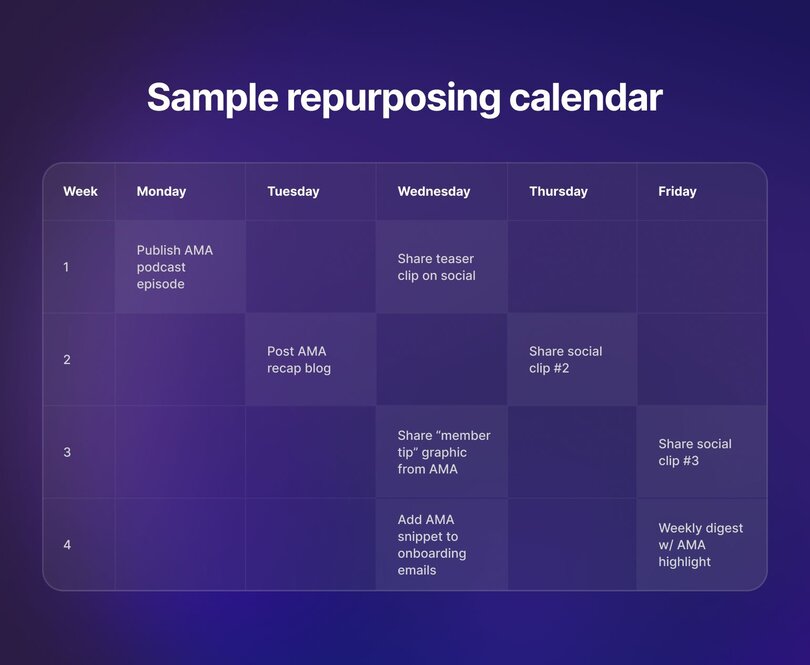
🔑 Advanced repurposing tips from Circle: Jerod Morris, Customer Success Manager at Circle, suggests a few advanced ways to stretch your system:
- Niche topic feeds: publish segments separately or in themed playlists (could even do private member-only feeds!)
- Turn episodes into a book: use AI to compile and edit content into a new format.
- Run a “Best Of” series: reshare top clips to refresh your archive and give yourself a break.
Bonus repurposing formula – “The Hat Trick” Framework
Sometimes the most challenging part of repurposing is figuring out how to spin one piece into something fresh. Jomiro’s solution? “I generally put on different hats as a first step.” In other words, he steps into the shoes of different audiences to find new ways to reframe the same idea.
For example:
- The visual learner hat → Turn your content into a simple graphic or slide with one key takeaway.
- The data-driven hat → Highlight statistics, references, or links (like a TED Talk) to back up your point.
- The thought leader hat → Pull out three quotable lines that others can share or reference.
Candice adds that you can also wear the hats of your own customer personas or members, asking, What problem would this solve for them? What would make them scroll past?
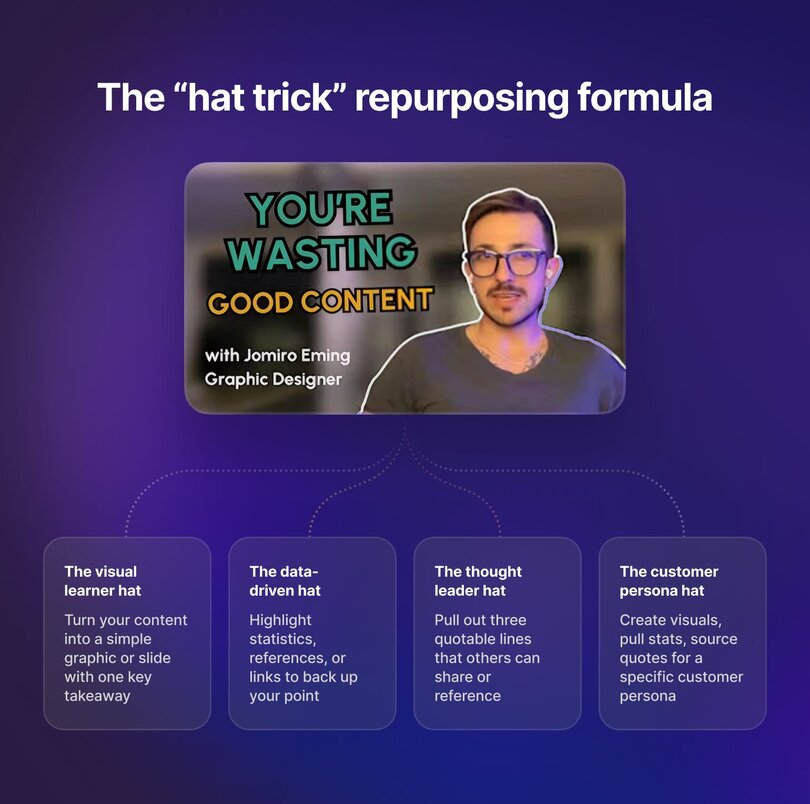
💡 Use “hats” as prompts to brainstorm formats. Or ask ChatGPT to role-play as these personas. You’ll get immediate feedback on what hits, what misses, and how to reshape your content for different audiences.
Tools stack for solopreneurs
The best content systems for solopreneurs is simple, affordable, and repeatable.
That’s the spirit behind Candice’s “scrappy systems” approach. And Jomiro’s workflow proves you don’t need dozens of apps.
Here are their go-to tools for content repurposing:
- Descript: Edit video from transcripts, clean up audio, and grab suggested clips for reels.
- Notion: An idea bank and lightweight content calendar. “You can collect ideas completely unfiltered and then link them into drafts,” Jomiro explains.
- ChatGPT: Pull timecodes and brainstorm titles.
- Zapier: Automate tasks, like forwarding client testimonials or newsletters straight into your Notion database.
- Buffer: Schedule posts in batches so you’re not context switching all the time.
💡 You don’t need a ton of tools. Many are free, others in this list max out at $50/month. (If you host events in Circle, they get automatically transcribed and become searchable within the community.)
That’s all you need to build a repeatable content repurposing system that saves you time without overwhelming your workflow.
Work with your content, not against it
Most people treat content like a treadmill. They run faster and faster just to stay in place. Repurposing flips that script. Instead of pushing out new ideas every week, you leverage the work you’ve already done, stay consistent without burning out, and build a system that compounds over time.
As Jomiro put it, “Content creation can become such an Everest to summit. To have motivation to continue doing it regularly is really hard.”
Repurposing lightens that climb. Turn a single event, blog, or podcast into graphics, clips, quotes, or summaries that reach more people in different ways.
“I genuinely think everything can be repurposed,” he explained.
💡 Your next step: Try out this content production system with your next event or post.
Design it for repurposing, plan your edits, batch the hard work, and schedule in blocks. You’ll spend less time scrambling and more time building momentum.